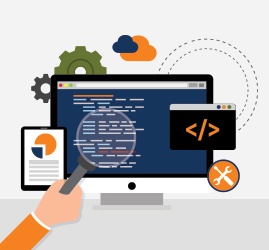In this expert series, we bring you the concepts that help to understand API testing and its tools/techniques used to perform so that you can employ the right kind of approach as per your testing requirements.
QASource Blog
In our blog, we take a deep dive into the latest QA strategies, methodologies, and industry best practices driving the world of quality assurance. Follow our blog to get new ideas as to how to effectively deliver high-quality, bug-free software products, websites, and applications, while keeping costs low.

QASource recently presented the webinar "Accelerate Your Automation With API Testing." In this webinar, QASource CEO Rajeev Rai discussed API testing's rise in popularity, and the necessity and benefits of testing APIs. The webinar also offered tips on how to perform API testing and best practices. We presented this webinar twice in September due to its popularity. During both live presentations, attendees were given the opportunity to ask questions, but we were unable to get to them all. Here, our expert API engineers answered them.
The phrase ’Internet of Things’, typically abbreviated as IoT, has been bouncing around in the tech industry for years. But there are still plenty of consumers—and even product company leaders—puzzling at its meaning. What is it? How does it impact the plain old “Internet” that I’ve grown to know and love? How does it affect my product, my business, and how my teams run tests?
APIs, or application program interfaces, are responsible for connecting everything and everyone to each other: Think using Facebook to sign into a music player app. Though APIs are integral to our interconnected way of life, they are not always tested, or tested thoroughly. Check out QASource’s latest infographic below to discover 6 reasons you should test your API.
Today, it seems like every app connects and integrates with the next. We can check out via PayPal, login via Facebook, and share content across all of our social media platforms at once. This interconnectedness helps people get more done in less time, leads to rapid growth for relatively young product companies, and creates a supportive ecosystem of well-crafted, well-tested applications. And all of it thanks to the essential bond, the tie that binds: the API (application programming interface).
Software companies work tirelessly to make their products as attractive and relevant as they can. One of the many ways they promote adoption and consistent use is through integration with other applications. When creating the code necessary to achieve this integration, engineers commonly refer to an API, or application programming interface. To put it simply, an API helps to define how components within both applications should interact.
It’s widely known that thorough API testing results in a high-quality final product. One question that lingers for many product companies, however, has to do with timing -- when should API testing be introduced? For many top QA teams, the answer aligns with the increasingly popular Agile methodology. For a strong, robust product, API testing is best performed in parallel with development.
The application programming interface (API) lays the groundwork for how your software components interact, and it helps guide your development team through the programming of the graphical user interface (GUI). Thorough API testing is the best way to ensure the functionality of your application's code and the API layer itself. Before partnering with an outsourced QA provider to begin testing your product, acquaint yourself with the advantages, approach, and associated tools of API testing.
Written by QA Experts
QASource Blog, for executives and engineers, shares QA strategies, methodologies, and new ideas to inform and help effectively deliver quality products, websites and applications.
Categories
Authors
Our bloggers are the test management experts at QASource. They are executives, QA managers, team leads, and testing practitioners. Their combined experience exceeds 100 years and they know how to optimize QA efforts in a variety of industries, domains, tools, and technologies.







